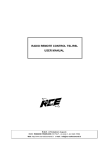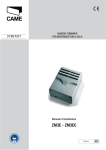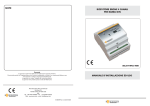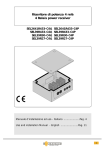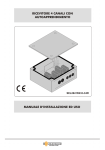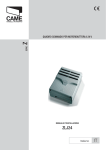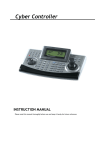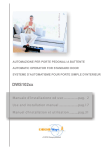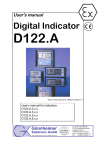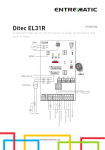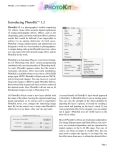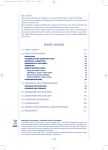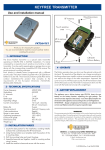Download scarica il manuale in pdf della centralina
Transcript
THE SMART LIVING PROGRAMMATORE ELETTRONICO MONOFASE SINGLE PHASE ELECTRONIC PROGRAMMER SEP230M210 Manuale d’installazione ed uso. . . . . . . . . . . . . . . . . . . . . . . Italiano Use and installation Manual . . . . . . . . . . . . . . . . . . . . . . . . . English THE SMART LIVING ITALIANO AVVERTENZE ITALIANO A.1 INSTALLAZIONE ! ! ! ! ! ! ! ! ! ! ! ! ! ATTENZIONE! Per la sicurezza delle persone, prima di iniziare l’installazione del prodotto leggere attentamente questo manuale e conservarlo per riferimenti futuri. Esso è rivolto a personale tecnico abilitato all’installazione di “Apparecchi utilizzatori di energia elettrica” ai sensi della legge N.46 del 5.3.1990 e richiede una buona conoscenza della tecnica, esercitata professionalmente e l’osservanza della legislazione locale, nazionale ed europea vigente. Una errata installazione o un errato uso può portare gravi danni alle persone. Questo prodotto è stato progettato e costruito esclusivamente per l’utilizzo indicato in questa documentazione. Qualsiasi altro utilizzo non espressamente indicato potrebbe pregiudicare l’integrità del prodotto e/o rappresentare fonte di pericolo. Gli elementi costruttivi meccanici devono essere in accordo con quanto stabilito dalle Norme EN 12604 e EN 12605. Per i Paesi extra-CEE, oltre ai riferimenti normativi nazionali, per ottenere un livello di sicurezza adeguato, devono essere seguite le Norme sopra riportate. Il costruttore non è responsabile dell’inosservanza della Buona Tecnica nella costruzione delle chiusure da motorizzare, nonché delle deformazioni che dovessero intervenire nell’utilizzo. Non installare il prodotto in ambienti a pericolo di esplosione o disturbati da campi elettromagnetici. La presenza di gas o fumi infiammabili costituisce un grave pericolo per la sicurezza. L’installazione deve essere effettuata nell’osservanza delle Norme EN 12453 e EN 12445. Prima di effettuare qualsiasi intervento sull’impianto, togliere l’alimentazione elettrica. Nel caso in cui non sia incluso nel prodotto, prevedere sulla rete di alimentazione, a monte dell’apparecchiatura un interruttore magnetotermico da 10A con interruzione omnipolare con distanza d’apertura dei contatti uguale o superiore a 3 mm. Verificare inoltre che a monte dell’impianto vi sia un interruttore differenziale con soglia da 0,03 A. Verificare che l’impianto di terra sia realizzato a regola d’arte e collegarvi le parti metalliche della chiusura. I dispositivi di sicurezza (norma EN 12978) permettono di proteggere eventuali aree di pericolo da rischi meccanici di movimento, come ad es. schiacciamento, convogliamento, cesoiamento. Per ogni impianto è consigliato l’utilizzo di almeno una segnalazione luminosa nonché di un cartello di segnalazione fissato adeguatamente sulla struttura dell’infisso, oltre ai dispositivi citati al punto precedente. L’installatore deve fornire tutte le informazioni relative al funzionamento manuale del sistema in caso di emergenza e consegnare questo manuale all’Utente utilizzatore dell’impianto. A.2 MANUTENZIONE ! Per garantire l’efficienza del prodotto è indispensabile che venga eseguita una manutenzione periodica da personale qualificato. Gli interventi di installazione, manutenzione e pulizia devono essere documentati e la documentazione deve essere conservata dall’utilizzatore e tenuta a disposizione del personale preposto al controllo. A.3 UTILIZZO ! ! ! ! Il prodotto è destinato all’uso per il quale è stato concepito. Ogni altro utilizzo è da considerarsi improprio o pericoloso. Non eseguire alcuna modifica sui componenti facenti parte del sistema d’automazione. Non permettere ai bambini o persone di sostare nelle vicinanze del prodotto durante il funzionamento. Tenere fuori dalla portata dei bambini radiocomandi o qualsiasi altro datore di impulso, per evitare che l’automazione possa essere azionata involontariamente. A.4 GARANZIA La garanzia è di 24 mesi dalla data di fabbricazione apposta all’interno. Durante tale periodo, se l’apparecchiatura non funziona correttamente, a causa di un componente difettoso, essa verrà riparata o sostituita a discrezione del fabbricante. La garanzia non copre l’integrità del contenitore plastico. La garanzia viene prestata presso la sede del fabbricante Pag . 2 THE SMART LIVING INDICE Avvertenze . . . . . . . . . . . . . . . . . . . . . . . . . . . . . . . . . . . . . . . . . . . . . . . . . . . . pag. 2 Presentazione . . . . . . . . . . . . . . . . . . . . . . . . . . . . . . . . . . . . . . . . . . . . . . . . . . pag. 3 Caratteristiche tecniche. . . . . . . . . . . . . . . . . . . . . . . . . . . . . . . . . . . . . . . . . . . pag. 4 Installazione . . . . . . . . . . . . . . . . . . . . . . . . . . . . . . . . . . . . . . . . . . . . . . . . . . . pag. 5 Schema generale collegamenti . . . . . . . . . . . . . . . . . . . . . . . . . . . . . . . . . . . . pag. 7 Legenda morsetti. . . . . . . . . . . . . . . . . . . . . . . . . . . . . . . . . . . . . . . . . . . . . . . . pag. 8 Configurazione dell’apparecchiatura . . . . . . . . . . . . . . . . . . . . . . . . . . . . . . . . . pag. 8 Impostazione dei dip-switch . . . . . . . . . . . . . . . . . . . . . . . . . . . . . . . . . . . . . . . pag. 9 Modi di funzionamento . . . . . . . . . . . . . . . . . . . . . . . . . . . . . . . . . . . . . . . . . . . pag. 10 Operazioni preliminari . . . . . . . . . . . . . . . . . . . . . . . . . . . . . . . . . . . . . . . . . . . pag. 10 Procedura di apprendimento . . . . . . . . . . . . . . . . . . . . . . . . . . . . . . . . . . . . . . . pag. 10 Descrizione ingressi . . . . . . . . . . . . . . . . . . . . . . . . . . . . . . . . . . . . . . . . . . . . . pag. 11 Descrizione uscite . . . . . . . . . . . . . . . . . . . . . . . . . . . . . . . . . . . . . . . . . . . . . . . pag. 13 Logica e dettagli di funzionamento . . . . . . . . . . . . . . . . . . . . . . . . . . . . . . . . . . pag. 14 Gestione dei radiocomandi . . . . . . . . . . . . . . . . . . . . . . . . . . . . . . . . . . . . . . . . pag. 15 Dichiarazione di conformità . . . . . . . . . . . . . . . . . . . . . . . . . . . . . . . . . . . . . . . . pag. 15 Presentazione Il programmatore SEP230M210 è una centrale di comando a microprocessore adatta al comando di 1 o 2 motori asincroni monofase da 230V / 450W , senza fine corsa. L’elettronica è equipaggiata con un ricevitore supereterodina integrato, funzionante a 433 MHz con decodifica del tipo KeeLoq® Hopping code. Particolarmente innovativo è il sistema di soft start-stop dei motori, con sense di corrente ed estrema facilità di messa a punto. E’ realizzata in conformità con tutte le Direttive Europee applicabili e le normative specifiche di prodotto. L'apparecchiatura è dotata di sicurezza intrinseca, che auto-regola la forza di spinta in funzione della corrente assorbita; riconosce gli ostacoli durante la corsa, arretra l'anta di qualche cm per liberare l'ostacolo, e si ferma in attesa di comando oppure inverte il moto secondo la configurazione impostata. Il tempo di pausa è regolabile a mezzo trimmer ( fino a 200 sec.). Si possono impostare 4 modi di funzionamento: ! ad azione mantenuta ( uomo presente ), ! semiautomatico, ! automatico con inversione ad ogni comando, ! automatico con stop ad ogni comando. L'apparecchiatura è alloggiata in contenitore plastico IP55 con grado di ignifugazione UL94-V0. THE SMART LIVING Pag . 3 Caratteristiche tecniche Programmatore Alimentazione. . . . . . . . . . . . . . . . . . . . . . . . . . . . . . . . . . . . . . . . . . . . . 230 Vac ±10% Frequenza . . . . . . . . . . . . . . . . . . . . . . . . . . . . . . . . . . . . . . . . . . . . . . . . . . . . . . 50 Hz N° motori collegabili. . . . . . . . . . . . . . . . . . . . . . . . . . . . . . . . . . . . . . . . . . . . . . . . . . . 2 Alimentazione motori . . . . . . . . . . . . . . . . . . . . . . . . . . . . . . . . . . . . . . . . . . . . 230 Vac Potenza motori . . . . . . . . . . . . . . . . . . . . . . . . . . . . . . . . . . . . . . . . . . . . . . . . 2 x 450W Corrente nominale . . . . . . . . . . . . . . . . . . . . . . . . . . . . . . . . . . . . . . . . . . . . . . . . . . 4 A Temperatura di esercizio . . . . . . . . . . . . . . . . . . . . . . . . . . . . . . . . . . . . . . . -20 / +85°C Grado di protezione contenitore. . . . . . . . . . . . . . . . . . . . . . . . . . . . . . . . . . . . . . . IP55 Grado di ignifugazione (UL94) . . . . . . . . . . . . . . . . . . . . . . . . . . . . . . . . . . . . . . . . . V0 Dimensioni (mm) . . . . . . . . . . . . . . . . . . . . . . . . . . . . . . . . . . . . . . . . . 319 x 223 x 100 Peso:. . . . . . . . . . . . . . . . . . . . . . . . . . . . . . . . . . . . . . . . . . . . . . . . . . . . . . . . . . 2,4 Kg Alimentazione lampeggiante . . . . . . . . . . . . . . . . . . . . . . . . . . . . . . 230 Vac 40 Wmax Alimentazione luce di cortesia . . . . . . . . . . . . . . . . . . . . . . . . . . . . 230 Vac 150 Wmax Alimentazione fotocellule . . . . . . . . . . . . . . . . . . . . . . . . . . . . . . . . . . 12 Vac - 100 mA Alimentazione ausiliaria . . . . . . . . . . . . . . . . . . . . . . . . . . . . . . . . . . . 12 Vac - 200 mA Tempo di pausa . . . . . . . . . . . . . . . . . . . . . . . . . . . . . . . . . . . . . . . . . . . . . 3 - 200 sec Ricevitore radio integrato Tipo di ricevitore:...................................................................................Supereterodina Demodulazione: ...............................................................................................AM/ASK Frequenza: .................................................................................................433,92 MHz Frequenza dell’oscillatore locale: ...............................................................6,6128 MHz Frequenza intermedia: ...................................................................................10,7 MHz Sensibilità ( per segnale a buon fine ):...........................................................-117 dBm Impedenza d’ingresso:......................................................................................50 Ohm Memoria tasti tx: ........................................................................................................85 Temperatura di funzionamento:..................................................................-20 / +70 °C Decodifica.................................................................................Keeloq® Hopping code Pag . 4 THE SMART LIVING Installazione 1) In base alla tipologia dell’impianto, individuare la posizione migliore dell’apparecchiatura in modo che sia in prossimità del cancello, al riparo da urti e manomissioni, ad altezza sufficiente dal suolo, al riparo da colmi d’acqua e facilmente raggiungibile dal tecnico per interventi di manutenzione. 2) Aprire il coperchio del contenitore svitando le 4 viti che rimangono prigioniere ed assicurarsi dell’integrità dell’apparato elettronico (Fig. 2). 3) Tracciare con l’aiuto della scatola i 4 punti di fissaggio o tenendo presenti gli interassi indicati in Fig. 1 4) Praticare i fori Ø6 mm per fissare i tasselli e fissare l’apparecchiatura con 4 viti autofilettanti M4. 5) Innestare i passacavi ( se forniti ) attraverso i fori presfondati e far passare i cavi di collegamento tenendo separati quelli di potenza da quelli di comando. 6) Nel caso non sia fornito con l’apparecchiatura, collegare a monte della linea principale di alimentazione un interruttore magnetotermico bipolare da 6A con distanza dei contatti di almeno 3 mm. Verificare inoltre la presenza di un interruttore differenziale da 30 mA a monte del collegamento di linea. 7) Eseguire le connessioni facendo riferimento allo schema di Fig. 3 ed alla tabella Tab. 2. THE SMART LIVING Pag . 5 Ø 6mm 195.4 285.4 Fig. 1 67 mm 2x 52 mm 2x Pag . 6 Fig. 2 THE SMART LIVING 24 25 POWER F 230 V N 230 V Schema generale dei collegamenti F1 26 27 L1 P3 Trasformatore 1 2 Fusibile 5A 3 4 5 6 7 SW1 8 P1 P2 FTC FTC-S CHIUDE APRE RV1 17 18 19 20 21 22 23 8 9 10 M1 M2 C1 C2 (*) 12Vac 0V 12Vac 0V 5 6 7 STOP LP L. CORTESIA 1 2 3 4 TX AUX FTC 11 12 13 14 15 16 Fig. 3 (*) : C1 e C2 devono essere di capacità adatta ai motori collegati. THE SMART LIVING Pag . 7 Legenda Morsetti Mors. N° 1 2 3 4 5 6 7 8 9 10 11 12 13 14 15 16 17 18 19 20 21 22 23 24 25 26 27 Descrizione I/U Luce di cortesia Luce di cortesia Lampeggiante Lampeggiante M1 Chiusura M1 Comune M1 Apertura M2 Apertura M2 Comune M2 Chiusura Alimentazione Aux Alimentazione Aux Alimentazione Fotocellule Alimentazione Fotocellule Contatto elettrico stop Contatto elettrico stop Contatto elettrico Apertura Comune Contatto elettrico Chiusura Contatto Fotocellula di Stop Contatto Fotocellula di Stop Contatto Fotocellula di Riapertura Contatto Fotocellula di Riapertura Fase alimentazione 230V Neutro alimentazione 230V GND Antenna RX radio Antenna RX radio Uscita Uscita Uscita Uscita Uscita Uscita Uscita Uscita Uscita Uscita Uscita Uscita Uscita Uscita Ingresso Ingresso Ingresso Ingresso Ingresso Ingresso Ingresso Ingresso Ingresso Ingresso Ingresso Ingresso Ingresso Tipo F 230 Vac N 230 Vac F 230 Vac N 230 Vac Motore1 230Vac 450W Motore2 230Vac 450W 12 Vac 0V 12 Vac 0V C NC NA C NA NC C C NC F 230 Vac N 230 Vac RG58 Tab. 2 Configurazione dell’apparecchiatura I terminali 230V sono accessibili sulla parte superiore della scheda e dotati di morsettiere estraibili. I terminali per lampeggiante, luce di cortesia, motori e per gli ingressi in bassa tensione sono accessibili nella parte inferiore e dotati di morsettiere estraibili. Eseguire i collegamenti secondo le dotazioni prescelte. La configurazione dei dip-switch segue quanto riportato nella tabelle 3 e 4. Pag . 8 THE SMART LIVING Impostazioni Dip-switch SW1 Il dip-switch SW1 consente di configurare l’impianto, a seconda delle proprie esigenze. L’impostazione di fabbrica prevede tutti i dip in posizione ON. Ciò consente di realizzare un impianto dalle seguenti caratteristiche: 2 motori con funzionamento automatico con richiusura, funzione condominiale attiva, funzione seguimi disattivata, test attivato su entrambe le fotocellule,sensibilità ostacolo: alta DIP N° Funzione ON OFF Comando di moto dinamico in apertura e chiusura ( apre – chiude – apre – chiude.. ) oppure ( apre – stop – chiude – stop..) a seconda del modo di funzionamento impostato. Funzione “Seguimi” attiva : al ripristino del fascio infrarosso FTC interrompe tempo di pausa e richiude 1 Funzione condominiale E’ attivo solo il comando di apertura. Durante la pausa, alla ricezione di un comando il tempo impostato dal trimmer riparte. 2 Seguimi Funzione “Seguimi” disattiva 3 4 Modo di funzionamento 5 Test su FTC-S (#) Test su Fotocellula FTC-S abilitato Test su Fotocellula FTC-S disabilitato 6 Test su FTC (#) Test su Fotocellula FTC abilitato Test su Fotocellula FTC disabilitato 7 8 Ved. Tab. 4A Sensibilità ostacolo Ved. Tab. 4B Tab. 3 (#) : I dip switch 5 e 6 consentono di escludere il test che viene eseguito sulle fotocellule FTC-S ed FTC, in caso queste non siano installate. Dip 3 Dip 4 Modo di funzionamento ON ON Automatico ( con inversione ) ON OFF Automatico ( con stop ) OFF ON OFF OFF Semiautomatico Azione mantenuta ( Uomo presente ) Richiusura automatica Abilitata Disabilitata ON Livello Sensibilità ostacolo (*) 4 molto sensibile (5%) OFF ON 3 sensibile (10%) ON OFF 2 sensibile (15%) OFF OFF 1 poco sensibile (20%) Dip 7 Dip 8 ON Tab. 4A Tab. 4B (*) : Alta sensibilità ( Liv. 4), significa che l’ostacolo viene rilevato se provoca una variazione superiore al 5% dei livelli standard. Bassa sensibilità ( Liv. 1), significa che l’ostacolo viene rilevato se provoca una variazione superiore al 20% dei livelli standard. THE SMART LIVING Pag . 9 Modi di funzionamento Modo Automatico: il ciclo inizia con un comando di moto, comprende le fasi di apertura (LP con intermittenza lenta), pausa (LP con intermittenza molto lenta) e chiusura (LP con intermittenza veloce); il ciclo si chiude con l'arrivo in battuta o con l'intervento del fine corsa di chiusura. Ad ogni comando il moto si inverte. La richiusura automatica è abilitata. Modo Automatico con Stop Il modo automatico con stop differisce da quello automatico per la presenza dello stop tra le fasi di apertura e chiusura. La richiusura automatica è abilitata. Modo Semiautomatico Il modo semiautomatico inizia con un comando di moto e termina alla fine del singolo ciclo ( in apertura con cancello completamente aperto o in chiusura con cancello completamente chiuso). Non vi è richiusura automatica. Modo Azione mantenuta ( Uomo Presente ) In questa modalità vi è movimento delle ante solo se il comando viene mantenuto: al rilascio ogni movimento cessa istantaneamente. Il questa modalità il lampeggiante LP ha una intermittenza rapida. Modo Allarme In questa modalità il funzionamento è identico al modo Uomo Presente. Vedere il paragrafo “Logica e dettagli di funzionamento” per le condizioni in cui si verifica . Operazioni preliminari 1 - Effettuare tutte le connessioni, seguendo lo schema di Fig. 5. 2 - Inserire l’eventuale ricevitore a scheda nell’apposito connettore, posto sulla scheda base dell’apparecchiatura. 3 - Impostare i dip-switches A e B in base alla configurazione d’impianto ed al modo di funzionamento desiderato. E’ consigliabile impostare inizialmente il funzionamento a Uomo Presente ( dip3=OFF, dip4=OFF) per verificare il corretto senso di apertura delle ante, prima di procedere con l’apprendimento dei tempi di viaggio. NB: Reimpostare successivamente la configurazione ( dip3=ON, dip4=ON) per procedere con l’apprendimento. Pag . 10 THE SMART LIVING Procedura di apprendimento Configurazione a 1 anta Configurazione a 2 ante A1 P2 A2 A1 Ante chiuse LP lampeggia rapidamente P2 LP lampeggia rapidamente A1 apre A1 apre P1 Anta chiusa P1 A1 stop (1) A1 stop (1) P1 P1 A1 chiude A2 apre P2 P1 Fine (1) LP Spento A2 stop (1) P2 P1 A2 chiude P2 (1) : premere il pulsante in prossimità della battuta A2 chiude & A1 chiude (2) (2) : Lo sfalsamento d’anta è calcolato automaticamente dal sistema Fine (1) LP Spento P2 Fig. 4 THE SMART LIVING Pag . 11 Ingressi Selettore a chiave Collegare un selettore a chiave con contatti NA agli ingressi 17-18-19. Ingresso di STOP Collegando un pulsante con contatto NC ai morsetti 15-16 si realizza una funzione di STOP. Attivando lo stop durante un movimento, il cancello si arresta istantaneamente e rimane in attesa di un comando: il lampeggiante lampeggia in modo RAPIDO Attivando lo stop durante la pausa, il cancello di arresta definitivamente e non richiude anche se richiusura automatica è abilitata. In questa condizione, a differenza dello stato di pausa normale, il lampeggiante è spento. Fotocellula FTC La fotocellula FTC se interviene durante la chiusura provoca l’inversione del moto. E’ soggetta al test di funzionamento prima di ogni chiusura ( vedere dettagli a pag. 13) Nel caso in cui venga ricevuto un comando di moto in condizione di fascio interrotto ( contatto NC aperto), il sistema segnala la condizione con un lampeggio molto rapido del lampeggiante che permane per tutta l’interruzione del fascio. Se il fascio viene liberato, tutto ritorna come prima. Se vengono ricevuti 3 comandi successivi di moto, in condizione di fascio interrotto, il sistema commuta in Modo Allarme. In questa condizione è in ogni caso possibile attuare un moto ( tramite selettore a chiave, comando ausiliario o radiocomando ) con un comando ad azione mantenuta. Il LED FTC è acceso se il contatto è chiuso. Fotocellula FTC-S La fotocellula FTS-S, se collegata, attua uno stop del movimento. Nel caso sia connessa ed il test sia abilitato, comporta gli stessi meccanismi validi per FTC. Il LED FTC-S è acceso se il contatto è chiuso. Uscite Lampeggiante Il lampeggiante con uscita a 230Vac/40W ha il comportamento descritto nella seguente tabella: Stato Cancello chiuso Apertura Pausa Funzionamento lampeggiante Luce SPENTA Lampeggio LENTO Lampeggio molto LENTO Chiusura Lampeggio VELOCE Allarme Lampeggio RAPIDO Uomo presente Lampeggio RAPIDO Autoapprendimento Lampeggio RAPIDO Stop Lampeggio RAPIDO Tab. 6 Prelampeggio Un prelampeggio di 1 sec. è sempre attivato e si verifica prima di ogni movimento. Luce di Cortesia Ai morsetti 1 - 2 è disponibile un’uscita 230 Vac / 150W per una luce di cortesia esterna. La luce di cortesia si accende all’inizio di un comando di moto e termina 30 sec. dopo il completamento del ciclo di chiusura. NOTA: se viene impostato il modo di funzionamento semiautomatico ( senza richiusura automatica ) al termine di un ciclo di apertura, la luce di cortesia rimane accesa in modo permanente. Essa si spegne solo 30 sec. dopo il completamente del ciclo di chiusura. Pag . 12 THE SMART LIVING Alimentazione Fotocellule AI morsetti 13, 14 è disponibile un’uscita a 12 Vac / 100 mA per l’alimentazione separata delle fotocellule. Questo consente di effettuare un test del funzionamento delle fotocellule prima di ogni moto, ai sensi dei requisiti della Normativa EN-12978. Logica e dettagli di funzionamento Test Fotocellule In conformità con quanto previsto dalla normativa EN 12978, l’apparecchiatura effettua un test di funzionamento delle fotocellule FTC prima di ogni movimento di chiusura. Il test consiste nell’interruzione dell’alimentazione delle fotocellule ( morsetti 13 - 14 ) e la verifica che il corrispondente contatto FTC e/o FTC-S si interrompe. Se per qualunque ragione il test fallisce, la centralina commuta in Modo Allarme. In condizione di Allarme è in ogni caso possibile movimentare le ante con un’azione mantenuta del comando ( sia a filo sia via radio). Se la fotocellula riprende a funzionare, il sistema esce automaticamente dal Modo Allarme. Esclusione del Test FTC E’ possibile escludere il test che viene sempre eseguito sulle fotocellule agendo sui dip-switch 5 e 6. ( ved. tab. 3) ATTENZIONE : Dato che viene escluso il test su componenti di sicurezza, tale collegamento deve essere eseguito solo allo scopo di ricercare eventuali malfunzionamenti dell’impianto oppure in caso di mancanza delle fotocellule nell’installazione.. In quest’ultimo caso è necessario sia ponticellare gli ingressi 20-21 ( FTC-S ) e 22-23 (FTC) sia agire sui dip-switch 5 e 6 per escludere il test. Rilevamento di un ostacolo Se, durante il funzionamento del cancello, viene rilevato un ostacolo che non consente di completare il ciclo in atto, il cancello prima libera l’ostacolo, e poi muove in direzione contraria. Viene successivamente fatto un secondo tentativo di completamento del ciclo e, se neanche quest’ultimo va a buon fine, la centrale commuta in Modo Allarme. Esclusione temporanea della richiusura automatica Se, con il cancello completamente aperto in pausa, si dà un comando di apertura, con chiave o radiocomando, mantenendolo per più di 4 sec., è possibile impostare temporaneamente il modo di funzionamento Semiautomatico, escludendo così la richiusura automatica. In questa situazione il lampeggiante si spegne, mentre la lampada spia, se collegata, rimane perennemente accesa. Al successivo comando di movimento, il modo di funzionamento precedentemente impostato viene ripristinato. THE SMART LIVING Pag . 13 Gestione dei radiocomandi La scheda è equipaggiata con un ricevitore radio operante a 433,92 MHz in AM Memorizzazione dei trasmettitori P3 2 lampeggi lenti L1 si accende L1 si spegne L1 rimane acceso 10 Sec. Tenere premuto P3 per 4 sec fino a quando LD1 si accende Rilasciare P3 Premere il tasto del trasmettitore da memorizzare Fig. 5 Cancellazione dei trasmettitori P3 L1 si accende P3 L1 lampeggia 2 lampeggi lenti L1 lampeggia L1 si spegne 10 Sec. Tenere premuto P3 Rilasciare Tenere premuto P3 per 4 sec fino a per altri 4 sec fino a P3 quando L1 si accende quando L1 lampeggia Rilasciare P3 Premere il tasto del trasmettitore da cancellare Fig. 6 Cancellazione completa della memoria P3 L1 si accende P3 L1 lampeggia Tenere premuto P3 Rilasciare Tenere premuto P3 per 4 sec fino a per altri 4 sec fino a P3 quando L1 si accende quando L1 lampeggia P3 Rilasciare P3 4 lampeggi lenti L1 si spegne Tenere premuto P3 per altri 4 sec fino a quando L1 fa 3 lampeggi lenti Fig. 7 Pag . 14 THE SMART LIVING Pulsanti P1 e P2 Il pulsante P1 presente sulla scheda logica , quando non utilizzato per l’apprendimento attua un comando di moto. Il pulsante P2 si utilizza esclusivamente per entrare ed uscire dalla procedura di apprendimento. Uomo Presente L’apparecchiatura funziona a Uomo Presente se viene impostato il modo di funzionamento relativo, mediante i dip-switch 3 -4 oppure se interviene una qualunque situazione di allarme. In questa situazione, i comandi possono essere dati solo ad azione mantenuta ed il lampeggiante funziona con intermittenza rapida. A meno che non sia impostato il funzionamento mediante i dip-switches, la modalità Uomo Presente permane finché la situazione d’allarme non viene rimossa. L’eventuale comando radio è abilitato, sempre ad azione mantenuta. Sfalsamento delle ante Lo sfalsamento delle ante sia in apertura sia in chiusura viene calcolato direttamente dal microprocessore. Esso è stato calcolato in modo da soddisfare sempre i requisiti di sicurezza imposti dalle norme vigenti. Funzione seguimi Quando attivata, con dip2=OFF, la funzione seguimi fa richiudere le ante non appena viene attraversato e liberato il fascio delle fotocellule FTC, senza attendere il completamento del tempo di pausa. Se il fascio non viene interessato, le ante attendono tutto il tempo di pausa prima di richiudere. Dichiarazione di Conformità CE ( secondo la Direttiva 98/37/CE, Allegato II parte C ) Il sottoscritto Luigi Bignotti, amministratore della società ELPRO INNOTEK SPA, dichiara che il prodotto: Nome del Costruttore: Indirizzo: Tipo: ELPRO INNOTEK SPA Via Piave, 23, 31020 S.Pietro di Feletto (TV) - Italy Programmatore elettronico 1-2 motori asincroni monofase 230Vac destinato all’automazione di un cancello, porta o portone. Modelli: SEP230M210 Risulta conforme ai requisiti essenziali di sicurezza previsti dalle seguenti Direttive Europee: Direttiva 73/23/CEE “Bassa Tensione” modificata dalla Direttiva 93/68/CEE Direttiva 89/336/CEE “Compatibilità Elettromagnetica” modificata dalle Direttive 92/31/CEE, 93/68/CEE e 93/97/CEE Direttiva 89/292/CEE “Direttiva Macchine” modificata dalla Direttiva 98/37/CE. Direttiva 89/106/CE “Prodotti da costruzione”. Norme di Riferimento applicate: EN 12445, EN 12453, EN 13241-1, EN 12978 S.Pietro di Feletto, 12/11/2007 Luigi Bignotti __________________________ THE SMART LIVING Pag . 15 ENGLISH REMARKS ENGLISH A.1 INSTALLATION ! WARNING! Before installing this product, read this manual carefully and keep it for future reference. It is aimed at professionally qualified “installers of electrical equipment”, and installers must respect the local, national and european regulations in force. Incorrect installation or incorrect use of the product could cause serious damage or harm to people. ! This product was designed and built strictly for the use indicated in this documentation. Any other use, not expressly indicated here, could compromise the good condition/operation of the product and/or be a source of danger. ! The manufacturer is not responsible for failure to observe Good Working Practice in the installation of this product, or for any deformation that may occur during use. ! Do not install the product in explosive atmosphere or in the presence of strong electromagnetic fields. Presence of gas of inflammable fumes constitutes a serious danger for safety. ! The installation has to follow the Regulations EN 12453 and EN 12445. ! Before attempting any work on the system, disconnect the mains electrical power. ! The mains power supply of the automated system must be fitted with an all-pole switch with contact opening distance of 3mm or greater. Use of a 10A thermal breaker with all-pole circuit break is recommended. ! Make sure that a differential switch with threshold of 0.03 A is fitted upstream of the system. ! Make sure that the earthing system is perfectly constructed, and connect any metal parts of the enclosure to it. ! The safety devices (EN 12978 standard) protect any danger areas against mechanical movement, such as crushing, dragging, and shearing. ! Use of at least one indicator-light is recommended for every system, as well as a warning sign adequately secured to the frame structure, in addition to the devices mentioned at previous point. ! The installer has to provide all the information about the manual operating of the system in case of emergency, and give this manual to the end user. A.2 MAINTENANCE ! To guarantee the efficiency of the product it is essential that a periodic maintenance is performed by qualified professionals. Installation, maintenance, repair and cleaning operations must be documented. The user must store all such documentation and make it available to competent personnel. A.3 USE ! The product must be used for its intended purpose only. Any other use is improper and therefore dangerous. ! Do not in any way modify the components of the automated system. ! Do not allow children or adults near the product while it is operating. ! Keep remote controls or other pulse generators away from children, to prevent the automated system from being activated involuntarily. A.4 WARRANTY Warranty period : 24 months from the production date placed inside. In this period if the appliance has any malfuction due to defective component, it will be repaired or replaced by the manufacturer. The warranty doesn't cover the plastic box All repairs will be effected at the manufacturers site. Pag . 16 THE SMART LIVING SUMMARY Remarks . . . . . . . . . . . . . . . . . . . . . . . . . . . . . . . . . . . . . . . . . . . . . . . . . . . . . . pag. 16 Introduction . . . . . . . . . . . . . . . . . . . . . . . . . . . . . . . . . . . . . . . . . . . . . . . . . . . . pag. 17 Technical specifications. . . . . . . . . . . . . . . . . . . . . . . . . . . . . . . . . . . . . . . . . . . pag. 18 Installing procedure . . . . . . . . . . . . . . . . . . . . . . . . . . . . . . . . . . . . . . . . . . . . . . pag. 19 Wiring diagram . . . . . . . . . . . . . . . . . . . . . . . . . . . . . . . . . . . . . . . . . . . . . . . . . pag. 21 Terminal boards. . . . . . . . . . . . . . . . . . . . . . . . . . . . . . . . . . . . . . . . . . . . . . . . . pag. 22 Set-up . . . . . . . . . . . . . . . . . . . . . . . . . . . . . . . . . . . . . . . . . . . . . . . . . . . . . . . . pag. 22 Dip-switch settings . . . . . . . . . . . . . . . . . . . . . . . . . . . . . . . . . . . . . . . . . . . . . . pag. 23 Operating modes. . . . . . . . . . . . . . . . . . . . . . . . . . . . . . . . . . . . . . . . . . . . . . . . pag. 24 Preliminary operations . . . . . . . . . . . . . . . . . . . . . . . . . . . . . . . . . . . . . . . . . . . pag. 24 Self-learning procedure . . . . . . . . . . . . . . . . . . . . . . . . . . . . . . . . . . . . . . . . . . . pag. 25 Inputs details . . . . . . . . . . . . . . . . . . . . . . . . . . . . . . . . . . . . . . . . . . . . . . . . . . pag. 26 Outputs details . . . . . . . . . . . . . . . . . . . . . . . . . . . . . . . . . . . . . . . . . . . . . . . . . pag. 27 Operating details . . . . . . . . . . . . . . . . . . . . . . . . . . . . . . . . . . . . . . . . . . . . . . . . pag. 28 Remote controls managing . . . . . . . . . . . . . . . . . . . . . . . . . . . . . . . . . . . . . . . . pag. 29 Declaration of conformity. . . . . . . . . . . . . . . . . . . . . . . . . . . . . . . . . . . . . . . . . . pag. 29 Introduction The electronic programmer SEP230M210 is a microprocessor based programmer which can drive 1 or 2, 230V/450W single phase asynchronous gear motors, without limit switches The programmer is equipped with an embedded superhetherodyne receiver operating at 433 Mhz with decoding type KeeLoq® Hopping code. The motors soft start-stop system, with current sense, is very innovative and the set-up procedure is very easy. The design follows all the constraints of the European Directives and the Product Regulations. The appliance is equipped with intrinsical safety, that self-adjusts the torque according to the absorbed current. If it detects an obstacle during travel, it moves the gate back to release the obstacle and waits for a command, or reverses the motion. Any movement is adjusted with soft start and stop, near the travel limits. The waiting time is adjustable with a trimmer ( up to 200 sec.). 4 operating modes are available: ! direct control mode, ! semi-automatic, ! automatic with travel direction reverse at each command; ! automatic with stop at each command. The appliance is housed in an ABS shockproof enclosure with IP55 protection grade and fireproofing grade UL94-V0. THE SMART LIVING Pag . 17 Technical specifications Programmer Power supply . . . . . . . . . . . . . . . . . . . . . . . . . . . . . . . . . . . . . . . . . . . . . 230 Vac ±10% Frequency . . . . . . . . . . . . . . . . . . . . . . . . . . . . . . . . . . . . . . . . . . . . . . . . . . . . . . 50 Hz N° of gear motors . . . . . . . . . . . . . . . . . . . . . . . . . . . . . . . . . . . . . . . . . . . . . . . . . . . . 2 Gear motor supply voltage . . . . . . . . . . . . . . . . . . . . . . . . . . . . . . . . . . . . . . . . 230 Vac Gear motor power . . . . . . . . . . . . . . . . . . . . . . . . . . . . . . . . . . . . . . . . . . . . . 2 x 450 W Rated current . . . . . . . . . . . . . . . . . . . . . . . . . . . . . . . . . . . . . . . . . . . . . . . . . . . . . . 4 A Operating temperature . . . . . . . . . . . . . . . . . . . . . . . . . . . . . . . . . . . . . . . . -20 / +85°C Enclosure protection grade . . . . . . . . . . . . . . . . . . . . . . . . . . . . . . . . . . . . . . . . . . IP55 Fireproofing grade (UL94). . . . . . . . . . . . . . . . . . . . . . . . . . . . . . . . . . . . . . . . . . . . . V0 Overall dimensions (mm). . . . . . . . . . . . . . . . . . . . . . . . . . . . . . . . . . . 319 x 223 x 100 Weight: . . . . . . . . . . . . . . . . . . . . . . . . . . . . . . . . . . . . . . . . . . . . . . . . . . . . . . . . 2,4 Kg Warning light supply . . . . . . . . . . . . . . . . . . . . . . . . . . . . . . . . . . . . . 230 Vac 40 Wmax Courtesy light supply . . . . . . . . . . . . . . . . . . . . . . . . . . . . . . . . . . . 230 Vac 150 Wmax Auxiliary devices supply . . . . . . . . . . . . . . . . . . . . . . . . . . . . . . . . . . . 12 Vac -200 mA Photocells supply voltage . . . . . . . . . . . . . . . . . . . . . . . . . . . . . . . . . . 12 Vac - 100 mA Waiting time . . . . . . . . . . . . . . . . . . . . . . . . . . . . . . . . . . . . . . . . . . . . . . . . 3 - 200 sec. Embedded radio receiver Receiver type: ....................................................................................Superheterodyne Demodulation:..................................................................................................AM/ASK Carrier frequency: ......................................................................................433,92 MHz Local oscillator frequency:..........................................................................6,6128 MHz Intermediate frequency: .................................................................................10,7 MHz Sensitivity ( for good signal ): .........................................................................-117 dBm Input impedance: ..............................................................................................50 Ohm Transmitter key memory:...........................................................................................85 Operating temperature: ..............................................................................-20 / +70 °C Decoding .................................................................................KeeLoq® Hopping code Pag . 18 THE SMART LIVING Installing procedure 1) Depending on the type of the gates, locate the best position for the appliance, close to the gate, safe from shocks and tampering, high enough from the ground, safe from water and easily accessible for maintenance operations. 2) Unscrew the 4 screws of the cover and verify the electronic card integrity. (Fig. 2). 3) Trace the 4 fixing points using the container as template mark or making reference to the distances shown on Fig. 1 4) Drill 4 holes Ø6 mm for the plugs and fasten the box with 4 x M4 screws. 5) Insert the cable holders ( if provided ) throught the pre-cuted holes and pass the cables, keeping the mains cables and low voltage cables seperated . 6) If not provided with the appliance, connect an all-pole 10A thermal breaker switch with contact opening distance of 3mm or greater. Make sure that a differential switch with threshold of 0.03 A is fitted upstream of the system. 7) Make the connections with reference to Fig. 3 and to Tab. 2. THE SMART LIVING Pag . 19 Ø 6mm 195.4 285.4 Fig. 1 67 mm 2x 52 mm 2x Pag . 20 Fig. 2 THE SMART LIVING 24 25 POWER Ph 230 V N 230 V Wiring diagram F1 26 27 L1 P3 Transformer 1 2 3 Fuse 5A 4 5 6 7 SW1 8 P1 P2 FTC FTC-S CLOSE OPEN RV1 17 18 19 20 21 22 23 8 9 10 M1 M2 C1 C2 (*) 12Vac 0V 12Vac 0V 5 6 7 STOP WL COURTESY L 1 2 3 4 TX AUX FTC 11 12 13 14 15 16 Fig. 3 (*) : C1 and C2 must be of the right value according to the motors used THE SMART LIVING Pag . 21 Terminal board connections TB N° 1 2 3 4 5 6 7 8 9 10 11 12 13 14 15 16 17 18 19 20 21 22 23 24 25 26 27 Description Courtesy light Courtesy light Warning light Warning light M1 Close M1 Common M1 Open M2 Apertura M2 Common M2 Chiusura Auxiliary supply Auxiliary supply Photocells supply Photocells supply Stop input contact Stop input contact Open input contact Common contact Close input contact FTC-S contact FTC-S contact FTC contact FTC contact Phase 230V input Neutral 230V input GND Antenna RX radio Antenna RX radio I/O Output Output Output Output Output Output Output Output Output Output Output Output Output Output Input Input Input Input Input Input Input Input Input Input Input Input Input Type F 230 Vac N 230 Vac F 230 Vac N 230 Vac Motor1 230Vac 450W Motor2 230Vac 450W 12 Vac 0V 12 Vac 0V C NC NO C NO NC C C NC Ph 230 Vac N 230 Vac RG58 Tab. 2 Set-up The 230Vac terminals are accessible from the upper side of the card main board and are equipped with pluggable terminal blocks. The low voltage terminals and the motors terminals are accessible from the lower side and equipped with pluggable terminal blocks. Make the connections according to the installation. Follow tables 3 - 4 for the dip-switch settings. Pag . 22 THE SMART LIVING Setting dip-switch SW1 The dip-switch SW1 allows setting up the installation, according to requirements. With the factory settings all dips are in the ON position. This configure a programmer with the following features: 2 motors without travel switches, automatic operating mode with automatic closing, condominium function, high sensitivity level. DIP N° Function ON OFF 1 Condominium function Only the opening command is enabled during the pause a command restarts the waiting time. 2 Follow me Follow me disabled Dynamic command in opening and closing ( open – close - open – close ) or ( open – stop – close – stop ) according to the set operating mode Follow me enabled : after the restore of the photocell beam FTC stop the waiting time and the gate closes. 3 Operating modes See. Tab. 4A 4 7 Test on FTC-S (#) Test on FTC-S enabled Test on FTC-S disabled 8 Test on FTC (#) Test on FTC disabled 9 Obstacle reaction sensitivity 10 Test on FTC enabled See. Tab. 4B Tab. 3 (#) : The dip switches 5 and 6 allow to disable the test executed on the photocells FTC-S and FTC when these are not installed. Dip 5 Automatic closing Dip 6 Operating mode ON ON Automatic ( with dir ection inversi on ) ON OFF Automatic ( with stop ) OFF ON Semi-automatic OFF OFF Manual operation Dip 9 Dip 10 ON ON 4 High sensitivity (5%) OFF ON 3 Medium level (10%) ON OFF 2 Medium level (15%) OFF OFF 1 Low sensitivity (20%) Enabled Tab. 4A Disabled Obstacle sensitivity Level (*) Tab. 4B (*) High sensitivity means that the obstacle is detected if it causes a variation greater that 5% over the rated values. Low sensitivity means that the obstacle is detected if it causes a variation greater that 20% over the rated values. THE SMART LIVING Pag . 23 Operating modes Automatic mode: This cycle starts with any motion command and includes the opening phase, ( LP with slow flashing ) pause ( LP always on ) and closing ( LP fast flashing ) ; the cycle ends when the gate hits the limit bracket or the closing switch has been activated. At each command the direction changes. The automatic closing is enabled. Automatic mode with stop This mode differs from the first one for the stop command between the opening and the closing. The automatic closing is enabled. Semi-automatic mode The semi-automatic mode starts with a motion command and finishes at the end of one cycle ( gate full closed or full open ) There is no automatic closing. Manual operation In this mode there is only movement of the gate if while the command is present - when the command is released , the movement stops at once. In this mode the warning lamp (LP ) flashes quickly. Alarm Mode In this condition the behaviour is identical to the Manual operation. See the paragraph “Operating details” for more information. Preliminary operations 1 - Make all the connections following the wiring diagram on Fig. 5. 2 - Plug-in the card receiver ( if provided) onto the special connector located on the main board of the appliance. 3 - Set the dip-switches A and B according to the requested configuration. NOTE : Before to proceed with the learning procedure it is advisable to test the right direction motion of the motors by setting both the dip switches 3 and 4 in OFF position. Restore the dip switches 3 and 4 in ON position before to commence the learning procedure Pag . 24 THE SMART LIVING Learning procedure 1 gate configuration 2 Gates configuration A1 P2 A2 A1 Gates closed LP flashes quickly P2 LP flashes quickly A1 opens A1 opens P1 Gate closed P1 A1 stop (1) A1 stop (1) P1 P1 A1 closes A2 opens P2 P1 End (1) LP Off A2 stop (1) P2 P1 A2 closes P2 (1) : Press the button at the gate stop. A2 closes & A1 closes (2) (2) : The gate offset is given by the system End (1) LP Off P2 THE SMART LIVING Pag . 25 Input details Key selector Connect a key selector with NO contacts to the inputs 17-18-19. STOP input A stop function is realized by connecting a NC contact to the terminal blocks 15-16. If the STOP command is given during any motion, the gate stops immediately waiting for a command : the warning light flashes quickly. If the STOP command is given during the pause, the gates blocks and doesn’t re-close even if the automatic re-closing is enabled. In this status, unlike the normal pause, the warning light is switched off. Photocell FTC The photocell FTC, when activated during the closing, causes the reverse of the motion. It is always checked by the operating test every motion ( see more details on pag. 28 ). If a motion command is received when the beam is broken, ( NC contact open ), the system detects a special condition and gives a warning with a quick flashing of th e warning light . When the beam is restored everything returns normal. If, in condition of broken beam, 3 consecutive motion commands are received, the system switches to Alarm mode . In this status it’s always possible to move the gates ( using the key selector, an auxiliary command or with the radiocontrol ) by continuously pressing the button. LED FTC is ON when the contact is shorted. Photocell FTC-S The photocell FTS-S when activated, causes a stop of the motion. If the photocell is connected and the test enabled, the actions are the same as for FTC. The corresponding led is ON when the contact is shorted. Output details Warning light The warning light (230Vac/40W) has the operation mode described in the following table : Status Gate closed Opening Warning light operation Light OFF SLOW flashing Pause Very slow flashing Closing FAST flashing Alarm QUICK flashing Manual Operation QUICK flashing Self-learning QUICK flashing Stop QUICK flashing Preflashing The preflashing of 1 sec. is always active and occurs before each motion. Pag . 26 THE SMART LIVING Tab. 6 Courtesy light Terminals 1 - 2 on the main board provide an output 230 Vac / 150W for an external courtesy light. The courtesy light switches on at the beginning of the motion and ends 30 seconds after the completion of the closing cycle. NOTE: In Semi-automatic mode ( with no automatic reclosing ) the courtesy light remains ON all the time. It will switch off only after the end of the closing cycle. Photocells supply output At the terminals 13-14 an output of 12 Vdc / 100 mA for the photocells power supply is available. Connect this output to the power supply input of the photocells. This allows the test of the photocells before any motion, according to the requirements of the Regulation EN-12978. Operating details Photocells test In conformity with the Regulation EN 12978, the appliance effects a test of the photocells before each closing motion. The test consists of the interruption of the power supply given to the transmitters and the checking of the contact FTC or FCT-S which has to open. If, for any reason, the test fails, the programmer switches the current operating mode into Alarm Mode. In Alarm Mode it is still possible to move the gates by continuously pressing the command button ( wired or by radio ). If, in Alarm Mode, the photocells restore their functioning, the system returns into the mode previously set. Photocell test exclusion It’s possible to disable the test onto to the photocells, by acting on the dip-switches 5 and 6. ( see. tab. 3 ) ATTENTION: To disable the test on a safety device can be dangerous. Do it only for debugging reasons or when the photocells are not connected. In this last case it is necessary : 1 ) to make a short between the inputs of the corresponding photocell not used ( 20-21 for FTC-S ) or 23-23 for FTC 2) to act on the dip-switches 5 and/or 6 in order to disable the test. Obstacle detection If, during the motion of the gates, an obstacle stops the movement and doesn’t allow the current cycle to finish, the gate first moves to the opposite direction to release the obstacle and then stops and waits for a command ( according to dip3-A settings ). A second attempt to complete the current cycle is performed and, if it fails again, the programmer switches to Alarm mode. Automatic reclosing temporary exclusion If in pause status, an opening command is given by pressing continuously the button for more then 4 sec., it is possible to disable the automatic reclosing. In this condition the warning light switches off and the indicator light remains lit all the time. At the next motion command, the current operating mode is restored. THE SMART LIVING Pag . 27 Remote controls management On the main board is enbedded a radio received operating at 433,92 MHz in AM. Follow the procedures below for the management of the remote controls. Transmitters memorisation P3 2 slow flashes L1 turns on L1 remains lit L1 turns off 10 Sec. Press down P3 for 4 sec. until the LED L1 remains lit. Release P3 Press the key of the transmitter you want to memorize 10 Sec. Fig. 5 Transmitters erasure P3 L1 turns on 2 slow flashes L1 blinks P3 L1 blinks L1 turns off 10 Sec. Press down P3 for 4 sec. until the led L1 remains lit. Release Press down again P3 for 4 more sec. until P3 the led L1 start to blink. Release P3 Press the key of the transmitter you want to delete Fig. 6 Complete erasure of the transmitter memory P3 L1 turns on Press down P3 for 4 sec. until the led L1 remains lit. Pag . 28 L1 blinks P3 Release Press down again P3 for 4 more sec. until P3 the led L1 start to blink. P3 Release P3 THE SMART LIVING 4 slow flashes Press down again P3 for 4 further sec. until the led L1 does 3 slow flashes L1 turns off Fig. 7 Manual mode The appliance operates in Manual mode if the dip 3 - 4 are both set OFF or an Alarm situation occurs. In this case the command can be given only by continuously pressing on the button, and the warning light will flash quickly. The Alarm Mode persists until the malfunction has been repaired. Opening / Closing delay The delay between the gates both in opening and in closing is calculated directly by the microprocessor of the programmer. Its value is set to fullfill the safety requirements of the Regulations. Function “Follow-me” If the dip2=OFF, the function “follow-me” re-closes the gates just after the beam of the photocells FTC is broken and left, without waiting for the end of the waiting time. If the beam isn’t broken, the gate waits for the total time before closing. CE Declaration of conformity ( according to the Directive 98/37/CE, Annex II part C ) The undersigned Luigi Bignotti, administrator of the company ELPRO INNOTEK SPA, declares that the product: Manufacturer: Address: Type: Models: ELPRO INNOTEK SPA Via Piave, 23, 31020 S.Pietro di Feletto (TV) - Italy Electronic programmer for 1-2 230Vac single phase motors 1-2 for gate, doors automations GEP230M210 is in compliance with the safety requirements of the following European Directives: Directive 73/23/CEE “LVD” modified by the Directive 93/68/CEE Directive 89/336/CEE “EMC” modified by the Directives 92/31/CEE, 93/68/CEE e 93/97/CEE Directive 89/292/CEE “DM” modified by the Directive 98/37/CE. Directive 89/106/CE “CPD”. Reference Regulations : EN 12445, EN 12453, EN 13241-1, EN 12978 S.Pietro di Feletto, 12/11/2007 Luigi Bignotti __________________________ THE SMART LIVING Pag . 29 NOTES THE SMART LIVING NOTES Manufactured by ELPRO INNOTEK S.p.A. Via Piave, 23 - I-31020 S.Pietro di Feletto (TV) - ITALY Tel. +39-0438-450860 - Fax. +39-0438-455628 Toll-free number: 800.53.46.46 e-mail: [email protected] - web: www.erone.com THE SMART LIVING IS-C230ERML Rev. 0 del 06/5/2008 Manufactured by ELPRO INNOTEK S.p.A. Via Piave, 23 - I-31020 S.Pietro di Feletto (TV) - ITALY Tel. +39-0438-450860 - Fax. +39-0438-455628 Toll-free number: 800.53.46.46 e-mail: [email protected] - web: www.erone.com THE SMART LIVING
This document in other languages
- italiano: Erone SEP230M210

































